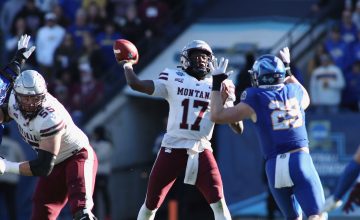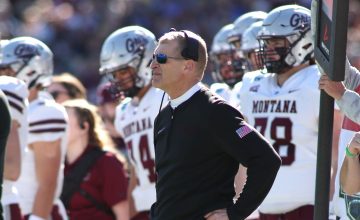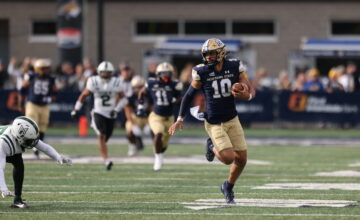The door opened and the intimidating presence emerged from an aircraft that had spent the last few hours five miles high, both literally and figuratively. Sonny Holland wore a leather jacket and a cowboy hat, the personification of Butte tough. The stout Bobcat legend held in his hands the NCAA Championship trophy, the second the greatest Bobcat of them all helped Montana State bring back to Bozeman.
As Holland stood atop the airplane stairs and looked out onto the runway, the throngs of locals waiting to welcome the Bobcats home burst into an ovation.
“I can still see it right now, 40 years later, that exact moment,” Bert Markovich said earlier this week. “That’s the defining memory of that moment, one of the pinnacle moments in all our lives.”
Forty years ago, Holland reached the pinnacle as a coach, replicating a feat he achieved 20 years earlier as a player. With each anniversary, each decade that passes, Bobcats’ run to the 1976 national championship becomes more entrenched in the lore of the Gallatin Valley. As Holland walked off the plane holding the national championship trophy, Mr. Bobcat stood on top of the world.
“The people in Montana like my father who never went to college, they loved Sonny Holland,” Markovich said. “The people of Montana, they loved him because of what he represented with his humility and authenticity. The professors, the farmers, the ranchers, the Butte miners, everyone loved him because he was so sincere. Then you add in the winning and you add in that championship and he is the greatest Bobcat of them all.”
As a four-year starter and three-time All-American, Holland carved out a career as a Bobcat legend, leading Montana State to its first football national championship in 1956. By 1976, he was in his sixth of seven seasons as the most successful head coach in school history, leading MSU to its second national title. But entering the campaign, no one could’ve predicted the success MSU would experience.
Holland led the Bobcats to the Big Sky Conference championship in 1972 in his second season as stars like Bill Kollar and Sam McCullum carved out their own places in MSU history. In 1973, 1974 and 1975, the Bobcats were one of the fiercest defensive units in all of Division II. Linebackers like Dusty Birkenbuel and Ron Ueland and defensive linemen like Kollar and Brad Daws stonewalled opponents with their vaunted 4-4 defense. Holland’s toss sweep offense featuring stud ball carriers like Steve Kracher and Wayne Edwards helped the Bobcats grind teams into the ground.
But MSU always battled new Big Sky member Boise State. Between 1973 and 1975, the Broncos — a former junior college accepted into the NCAA in 1969 — used Tony Knap’s innovative pro-style offense to pile up 29 wins in three seasons, earning Big Sky titles all three years. The Bobcats were the Big Sky runners-up to BSU in 1973 and 1974.
In 1975, Kracher rushed for 218 yards and helped MSU to a 34-28 lead with 37 seconds to play in Boise. On a sweep play, Boise State linebacker Gary Rosolowich stripped Kracher as the Bobcat runner was on his way out of bounds. The Broncos recovered and scored seconds later to lift BSU to a 35-34 victory that dropped MSU top 1-4 and sparked the host’s run to a third straight BSC title.
“We could’ve sacked our bats after that heartbreaker at the gun,” said Daws, an All-American his senior season in 1975. “But we won our next four that year, which gave those guys momentum heading into ’76.”
Still, with the departure of so many great players, from Kracher to all-time leading scorer kicker Pat Bolton to quarterback Mike Holder to a whole collection of physically intimidating defensive players, expectations were tempered entering 1976. The Bobcats were picked to finish fourth in the seven-team Big Sky Conference.
The roster featured just 10 seniors, including four fifth-year players like Marcovich and linebacker Tim Nixon, the team’s captains. Les Leininger returned at defensive end to anchor the defensive line, Vince Dodd returned in the secondary to lead the way from his strong safety position and senior Dave Mueller returned to flank Nixon. Senior Don Ueland provided a senior presence in an offensive backfield otherwise staked with first-year starters at quarterback, running back and fullback.
“You really had this dynamic that the talent, the really best players were sophomores and juniors,” Markovich said. “You had these seniors who played behind these tremendous stars, Bill Kollar, Ron Ueland, Dusty Birkenbuel, Wayne Edwards, Brad Daws. You had this mindset of just happy to be there because of the greatness ahead of us. There was no ego on that team.”
“The big thing was we had great senior leadership,” Rick Vancleeve, an All-Big Sky sophomore defensive tackle on the 1976 team, said. “I don’t think a lot of those guys got all-conference or anything but they were the heart of the team. We returned many players off that team the next two years and never quite ended up in the same position. That was a perfect meld of senior leadership and young punks.”
The Bobcat offensive front featured future NFL talent Jon Bortchardt, a 6-foot-5, 220-pound sophomore, and Bob Lubig, a 6-foot-5, 225-pound junior starting at tackle, the 6-foot-2, 225-pound Markovich playing center, and junior Lee Washburn (6-6, 248) and senior Ken Verlanic (6-3, 234) starting at guard. Junior Ron McCullogh (6-3, 223) was the top team in the Big Sky that season.
The group was tasked with paving the way for Holland’s physical toss sweep offense. Paul Dennehy, a sophomore from Butte Central, had just one season of starting experience as a quarterback for the Maroons because he sat behind record-setting Mark Schulte until his senior year. Dennehy’s athleticism running the option and the quarterback sprint out coupled with Delmar Jones’ athleticism from the fullback spot and Tom Kostrba’s grit at tailback helped the Bobcats establish their identity and punish teams throughout the ’76 season. The Bobcats rushed for nearly 290 yards per outing.
“The key to our championship run was our offensive front,” Dennehy said. “Our offensive front was rock solid. Our running game set the tone for everything we did. I think most people would agree, including Coach Holland, that was the best offensive line in Montana State history.”
The roster contained a distinct number of personalities hailing from all over the West. The Bobcats had 37 Treasure State products on their roster, including nine from Butte, Holland’s hometown. The out of state players mostly hailed from regional cities like Spokane, Seattle and the Twin Cities in Minnesota.
“The best way to describe our team was we had a third of out of state guys, a third of in-state guys and a third Butte guys,” Vancleeve said. “Butte is their own state. And our coaching staff were all Butte, all Butte tough.”
The Bobcats set the tone for their powerful style and resilient attitude right away. Montana State began its season in Grand Forks, North Dakota.
“Every time we went over there to Grand Forks, it would be 85 degrees, humidity like crazy and the wind would be blowing hard,” Markovich said. “They’d win the toss, defer, kick it off to you, you’d go three-and-out, punt it into the wind and they would get the ball on your 40-yard line. They would do that all first quarter, you’d be down 21-0 and it would be over before it began.”
The same scenario played out in the opener. In his first career start, Dennehy struggled to settle in initially and the Bobcats fell behind 14-3. Holland’s staff included Don Christensen, Howard Ross, Cliff Hysell and Sonny Lubick, the latter two future Bobcat head coaches themselves. Each and every one of the coaches talked to Dennehy, galvanizing him to guide the Bobcat offense to 15 unanswered points.
“That was the day Paul grew up as a player and we all believed in him after that,” Markovich said.
On the other side, Montana State’s revamped defense — now running a 5-2 instead of the old 4-4 — smothered the Fighting Sioux in MSU’s 18-14 win. With Vancleeve and junior Dick Lyman, a pair of 250-pound Great Falls products, controlling the interior, Leininger making plays on the end, and Dodd, Jim Mickelson and Ron Muri roaming the back end, the Bobcats ended up giving up 10 points per game the rest of the season.
Following the UND win, in Bozeman, Montana State bludgeoned North Dakota State with its powerful rushing attack in a 34-7 win. Against former head coach Jim Sweeney in Fresno, the Bobcats incurred their first loss, 24-10.
Vancleeve recalls the Fresno State loss being the only one of MSU’s 13 that season in which the Bobcats did not say a prayer. The team never missed another pre-game invocation.Following the defeat, the coaches switched Jones, a talented 200-pound sophomore who would earn All-Big Sky honors in 1977, to fullback to provide a speed option to compliment Kostrba’s power. With conference play beginning, Markovich remembers the coaches using a platoon where backups played every third series on both lines, in the backfield and throughout the second two levels of the defense.
October began with “the test, the team to beat in the Big Sky for the entire 70s,” Dennehy said: Boise State. The Bobcats avenged their heartbreaking loss from the season before, winning 24-20. Confidence began to grow.
Montana State destroyed Weber State 44-0 in Ogden before beating Idaho State 28-7 and Idaho 29-14 at Reno H. Sales Stadium in Bozeman. MSU closed the month with a 21-12 over rival Montana in Missoula, Holland’s ninth in 10 career outings against the Griz. November began with a 33-0 win over Northern Arizona in Bozeman to sew up MSU’s sixth Big Sky title in the league’s 14 years of existence.
The highlight of the Big Sky clincher came Leininger thwarted an NAU drive late in the first half by intercepting a pass and running it the length of the field for a touchdown.
“Les ran about a 5.5 40 and somehow went 85 yards into the end zone,” Vancleeve remembers. “On that play, Hysell was running down the sideline step for step with him and I think Hysell had to jog because he’s way faster than Les. Hysell had the head set on and when Les broke clean, Cliff’s cord got caught around his neck and his feet got pulled right out from under him (laughs).”
Montana State went into its regular-season finale at Division I-A Hawaii with the No. 1 national D-II ranking. Markovich joked the trip marked the first time “ a bunch of us Montana cowboys had ever seen any sun on our legs.” Senior tight end Al Reichow tore up his knee earlier in the year and Holland told him he could not go on the trip unless he intended to play. So the Bobcats rallied a collection of money and bought Reichow a ticket to come along to island paradise.
“That’s the kind of team we had,” Holland said during the unveiling ceremony for a statue of his likeness revealed at Bobcat Stadium on on the eve of MSU’s 2016 Homecoming game. “They loved each other, cared for each other and did whatever we took.
“Plus, the reason they bought him a ticket on the plane is Al had a bachelor party planned on the beach.”
MSU won that one too, rolling to a 28-7 win in Hawaii to move to 9-1 and earn a bid to the playoffs, the school’s sixth postseason berth. On the trip home, the plane had to make several emergency landings due to engine troubles, the first in a season filled with travel issues. Any time the Bobcats encountered an issue at the airport, Holland would take the team back to Brick Breeden Fieldhouse and conduct a practice.
“We would laugh about it and make fun of whoever got the most afraid,” Vancleeve said. “But maybe the games were easier because all we really worried about was getting there and getting back. Once we got to the field, we knew we would win.”
The playoffs began on a crisp, frigid Bozeman afternoon on November 27 against New Hampshire. The Bobcats bolted out to a 17-0 lead over the Wildcats.
“When I woke up that morning, it was nine below,” Dennehy said. “I remember going in at halftime and going back out, wondering if it was even possible to warm back up.”
“That was the coldest football game I’d ever played in in my life,” Markovich, a Butte native himself, said. “My wife, who was my girlfriend at the time, came down and she spent the whole game in the bathroom it was so cold.”
New Hampshire stormed back to cut the Bobcat lead to one but a missed extra point gave MSU a 17-16 win and a bid to the Grantland Rice Bowl for a rematch with NDSU, this time in Fargo. That afternoon proved to be as chilling and NDSU’s Astroturf complicated things even further.
“The coaches decided we needed to get new turf shoes so we got some new shoes from this funny new company called Nike none of us had ever heart of,” Markovich said, who ended up wearing Hysell’s coaching shoes instead.
“We got those shoes and ran on to the field and we weren’t used to it, first time on turf, on national TV, some of us fell right on our face,” Vancleeve said.
The Bobcats scored 10 second-half points, all by freshmen, including a key field goal by Jeff Muri in a stiff wind, to advance to the Division II national championship game with a 10-3 win. Kostrba carried MSU with 32 carries for 106 yards as the ‘Cats survived a minus-21 degree freeze.
“We thought we were into the championship, going to Texas, we’d have some good weather,” Dennehy said. “We get to Wichita Falls and it was even colder. The coaches that night went out looking for sweatshirts and long johns because we didn’t pack for it.”
On the way to the title game on December 11, the Montana State again encountered travel issues and again returned to campus to practice. MSU arrived in Wichita Falls late for the welcoming banquet.
The week leading up to the game, the Bobcats heard all about how big, strong, fast and athletic Akron would be. The Zips, after all, were on their way up to Division I two years later and the fertile Ohio recruiting grounds sprinkled talent across their roster.
When Montana State arrived at the banquet hall dressed exactly like you’d expect a group of young men from Montana to be, Akron had already finished eating. But the Zips waited for the Bobcats with other intentions.
“They were cat calling us, making fun of our Montana cowboys,” Holland said. “We had some big ole’ cowboys. Lee Washburn, a big, strong kid from Bozeman, he was pissed off. Our kids were really quiet, didn’t say a thing , but we didn’t forget that. Then we went out and kicked their ass.”
After slugging out the first quarter, Dennehy tossed a five-yard touchdown to McCullough for MSU’s first score. Later in the second quarter, Ueland threw a touchdown to sophomore Butch Damberger on a halfback passes. Ueland, Kostrba and Jones helped MSU piled up 266 rushing yards and Jeff Muri hit a 21-yard field goal as MSU build a 17-0 third-quarter lead.
Akron forced two turnovers that led to 13 quick points and a third takeaway gave Akron one last chance. But the Bobcat defense stiffened and Kostrba punched in a touchdown from eight yards out to seal victory.After Kostrba’s score, he handed the ball to Washburn, who spiked the ball and took the penalty, a completely uncharacteristic display of showboating for a Holland-coached team.
“The most shocked people in the stadium were me and the coaches,” Holland said. “We just didn’t do that stuff. But looking back on it now, it was pretty funny.”
After the game, a sideline reporter for the nationally televised broadcast grabbed Leininger for an interview. The reporter asked how the Westby native’s eight-man football background helped him prepare him for that moment.
“Well,” Leininger replied, “they give you the ball and you run your ass off.”
Following the 1977 season, Holland abruptly retired at the age of 39. Although Sonny Lubick, Doug Graber and Dave Arnold all led MSU to Big Sky titles — Arnold winning a national championship in his second of four seasons in 1984 — the Bobcats have searched to regain the dominance of the Holland era.
As the ’76 championship fades farther into the past, the reverence for the group grows. On Saturday, Montana State honors the 40th anniversary of the title at its Homecoming game that doubles as its Big Sky opener against, fittingly, North Dakota. MSU will also honor the 60th anniversary of the ’56 title team.
Dozens of former Holland players, from the 1976 team and other squads included, attended the unveiling ceremony to see the two-ton bronze memorial of their mentor. Vancleeve, Ueland, Markovich, Dennehy, Jones, Daws and Wayne Edwards spearheaded the construction of the statue.
Markovich emceed the event with Holland receiving praise from all who attended. While Holland is now immortalized forever by the bronze and is widely recognized as the pinnacle figure in the history of Bobcat athletics, the men who went to war for him some 40 years ago have brought him as much pride as anything he accomplished individually.
“That’s really the most spectacular part is to stand back and observe the men they’ve become, the way they’ve raise their families,” Holland said. “They are recognized and remembered as great players but they’ve also been great contributors to the communities they live in around the state and around America. I’m so proud of them all.”
Photos courtesy of Montana State Athletics or noted. All Rights Reserved.






















